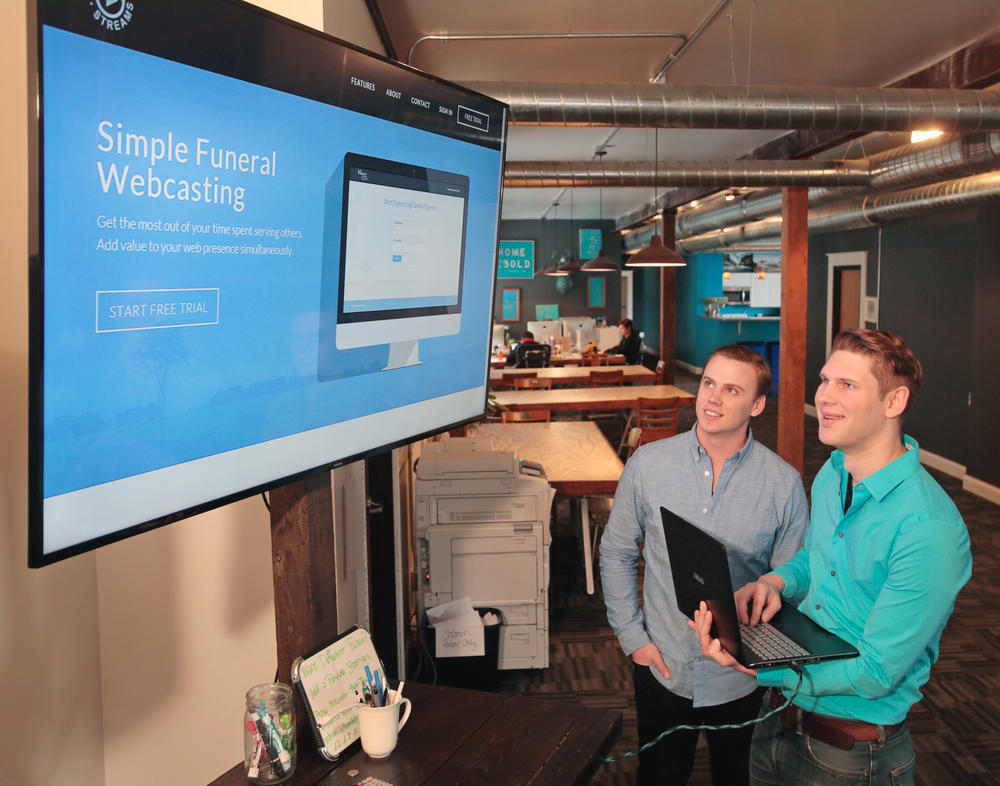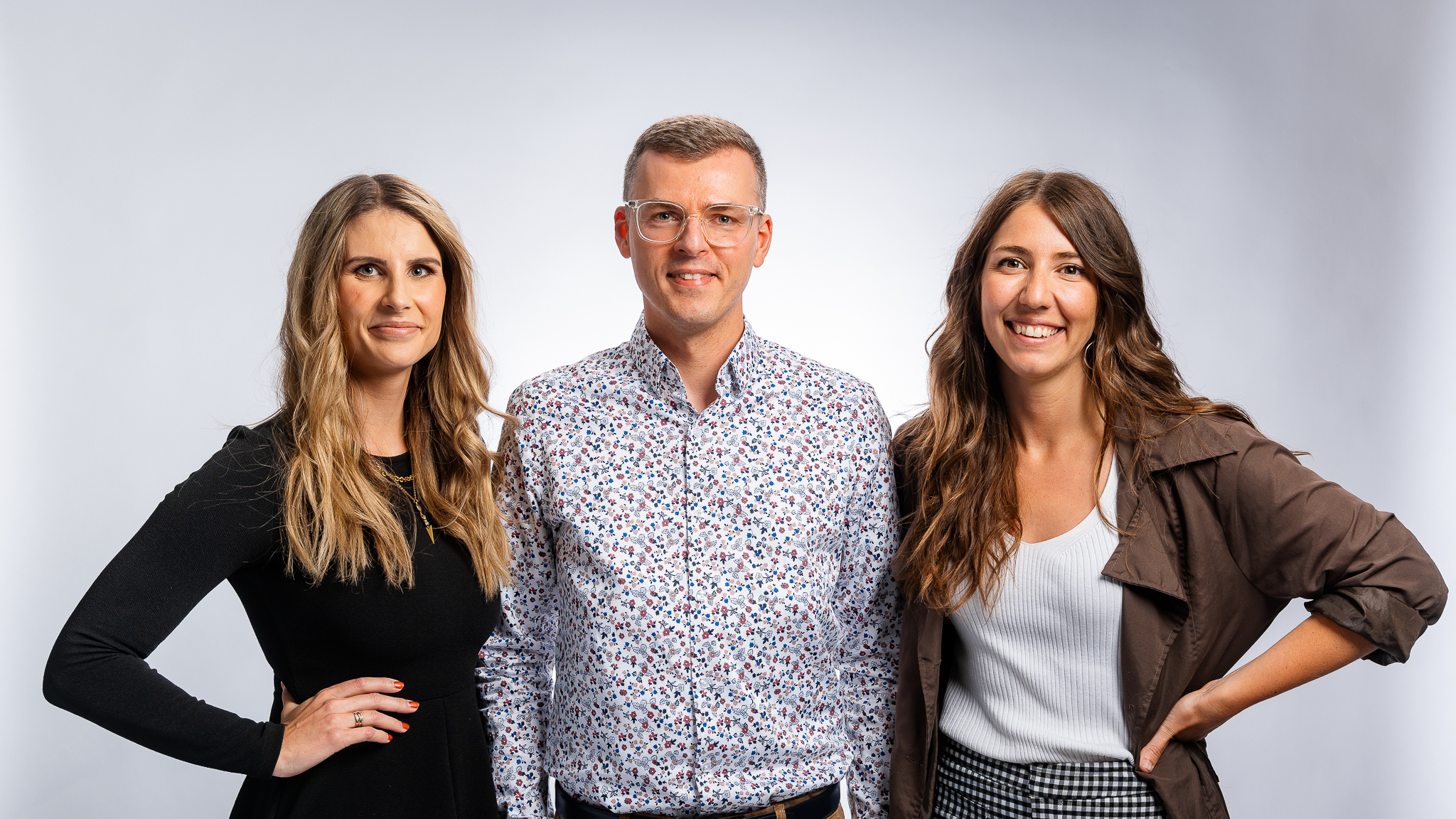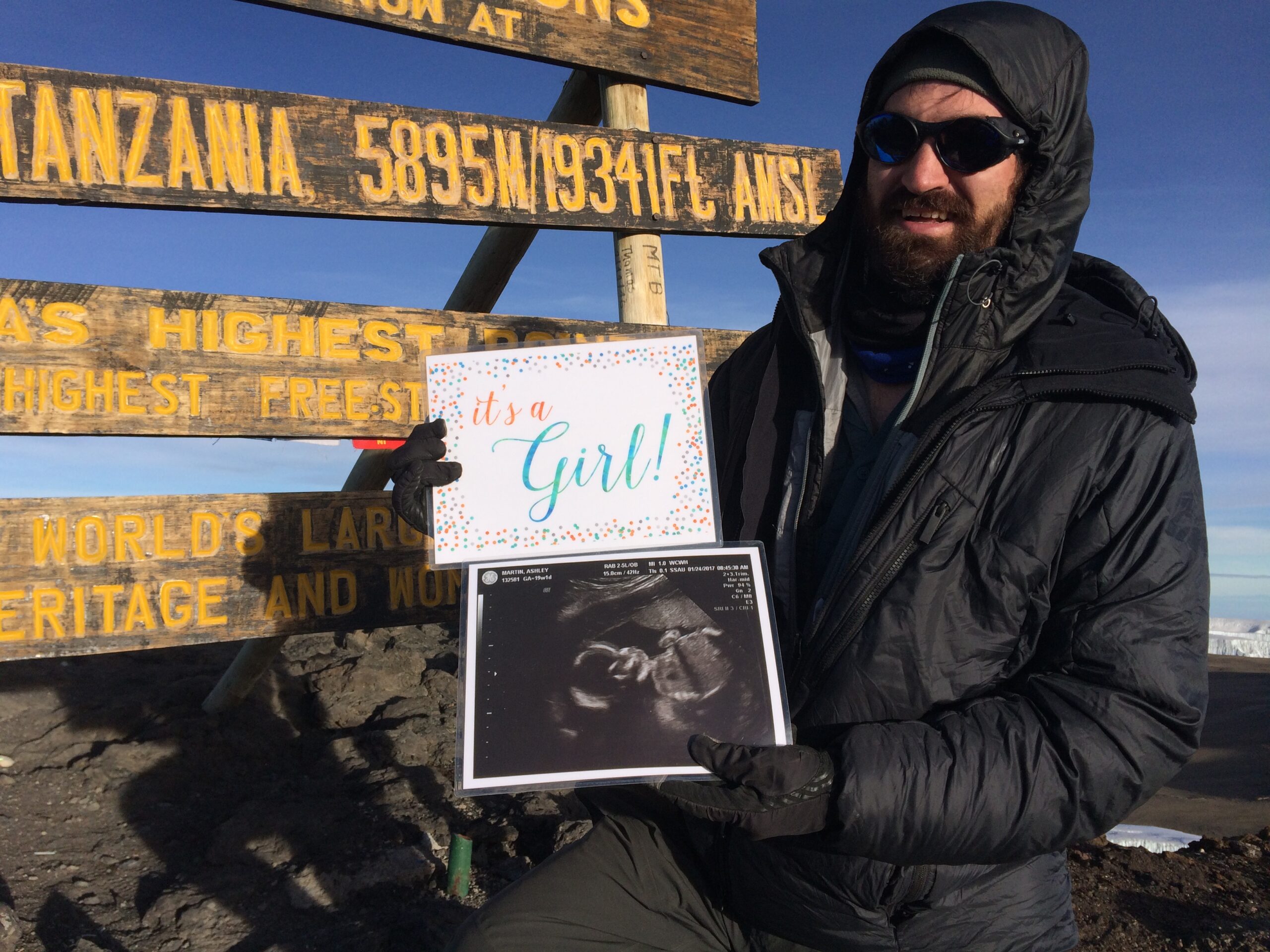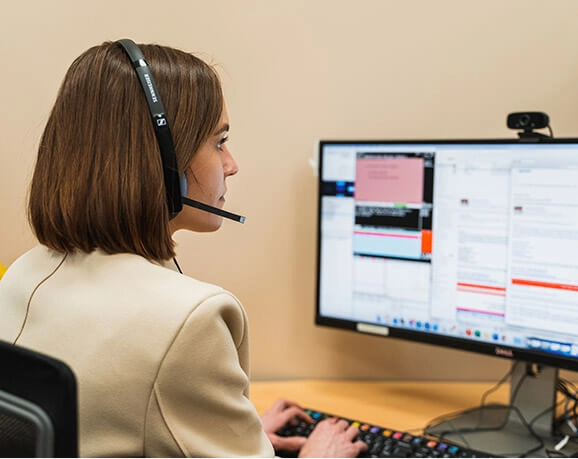By Thomas A. Parmalee
Kyle Fogarty was in a rock band in college, playing guitar at a bar in Fargo, North Dakota, where he kept getting distracted by the guy in the front row.
It was 2011, and the man in question was making the most out of the night’s Halloween theme by parading around in a Burger King crown and singing his heart out to every song the band played.
Shane White, now 32, was a friend of the band’s drummer, and he would eventually want more out of his relationship with Fogarty – he wasn’t content with simply attending Skooba concerts (the name of the band, which specialized in punk, rock and pop) and distracting its members by trying to compete with the lead singer.
No, he wanted to start a business, one that had little to do with music. Despite that, he’d done some asking around, and by the time he had a real conversation with Fogarty a few months later, he was pretty sure he’d found someone with the right skills to join him for the ride.
“He pitched me on the idea, and I was like, ‘This is a no brainer,’” Fogarty, now 31, said. “We got to work.”
The work ended up being an app that the profession knows today as MemoryShare, a simple livestreaming solution for funeral homes. They founded the company in 2012 as Midwest Streams.
“It initially made sense to call it Midwest Streams as we had strong ties to the Midwest,” Fogarty said. “Also, we started going to state funeral conventions, and we realized very quickly that people were not equating video with the word ‘stream.’ People thought we were a water company.”
The two would eventually rebrand the business as MemoryShare.
“We made a huge list of names, and we investigated to see if the .com version of those names were available at a price that made sense for us,” Fogarty said. “Also, having a name that didn’t have a direction in it allowed us to be a national brand, although the bulk of our business was in the Midwest prior to the pandemic.”
The new name has worked.
“Nobody asked what we were doing,” Fogarty said. “The name makes sense for what we do.”
The duo also came up with the logo – a start icon in a cloud. “We hired a bunch of designers to design logos and we ended up not liking them,” he said. “Just like our software, we wanted our logo to be as simple as possible. We took inspiration from Apple and Microsoft Azure with their clean, concise logos. We wanted to emulate ‘cloud-based video’ in logo form. Clouds are popular for software companies, and we used the play icon from the video world.”
Funeral Service as the Focus
The primary focus of the business has always been on serving funeral homes.
“It made a lot of sense for us to do funerals instead of weddings,” Fogarty said. “Everyone goes to a funeral home when someone passes.” He continued, “We thought about high school sports, and we thought about wedding venues. But those videos don’t matter as much as funeral livestreaming or a funeral recording – that carries with it a high value.”
The idea, Fogarty said, was all White’s, a master software developer and one of the best coders you will find. When it came to video, however, he lacked expertise.
“I was a video producer and had done a lot of camera work,” Fogarty said, noting he’d bounced around Hollywood, making commercials and working for Poker TV to boot. “We also had both started a couple of companies ourselves, and we realized we both had the desire to create something meaningful and big. That was always the goal. But it was Shane’s idea – it was all him.”
Fogarty explained, “Earlier in life, Shane was affected by a loved one passing, and he couldn’t go to a funeral home and record it. At that point, he was like, ‘This isn’t right.’”
White and Fogarty conducted market research, reaching out to Shane Decker, a regional director with Vertin Co.
“We reached out to him and asked if we could film a commercial for him, and in exchange, if we could work with him to flesh out our idea,” Fogarty said. “We started to talk, and then we got a meeting with his boss, Jay Dietz. Jay was the one who gave us the green light to work with some of his firms.”
Fogarty explained, “We drove to Breckenridge, Minnesota where Vertin headquarters was at the time, and did an in-person demo for Jay and his team. After the demo, Jay agreed to let us deploy our software with Shane Decker’s location in Morris, Minnesota at Pedersen Funeral Home and Andrew Yaggie’s firm, Glende-Nilson in Fergus Falls, Minnesota. At the time, we had no idea who Vertin Co. was or how important that opportunity was for us. That meeting changed the course of our lives forever and inadvertently allowed us to prepare for the unprecedented demand the pandemic would bring eight years later.”
He added, “They looked at us as 22-year-old kids and figured to give us a shot,” Fogarty said. “We worked really closely with seven funeral homes. We watched the whole process to learn what they needed, where is the best place to set up a camera, etc. Through those several funeral homes, we built what MemoryShare is today. We owe a lot to Vertin Co. for taking a chance on us.”
They built the app on refurbished laptops in a basement and in a kitchen. To this day, MemoryShare still serves Vertin Co., Fogarty said.

Plotting a Path
As counterintuitive as it may sound, when the business partners mentioned their idea to people outside the profession, everyone responded with, “That is awesome.”
But within the profession, there was pushback.
“In the early days, funeral directors were like, ‘Why would I do that?’” Fogarty said.
Many funeral homes looked at the two founders as if they were just another technology company trying to sell them something they did not need. “It was really hard to validate the idea,” Fogarty said. “But a couple of directors we did find, and they said, ‘Yes, that makes sense.’ There were little pockets.”
One of those early adopters was Matt Bailey, a sixth-generation funeral director and the president of Connecticut Life Tributes. “I’m a big fan of Kyle and Shane and MemoryShare,” he said. “They are bright and truly focused on elements of livestreaming that benefit the funeral home, but no other provider seems to talk about.”
Bailey shared that his firm has been offering livestreaming for about 20 years, soon after he joined the business full time. When the vendor the firm was using at the time fell short of the funeral home’s expectations, the time was ripe to try a new service, he said.
“Sometime later, I was attending a convention and encountered Kyle and Shane of what was then known as Midwest Streams,” Bailey said. “We had a good conversation. My impression of them was that they actually cared, and they were devoted to providing a reliable service that would make a difference for grieving families and the funeral professionals who were working to help them. I left that convention with a digital video camera, a tripod, and other ‘startup’ items needed to provide streaming services to our client families.”
Although families were slow to opt for the service, Bailey remained convinced that it made sense to continue offering the service. “I still believed in the value of the concept and found in Kyle and Shane a genuine desire to partner with funeral professionals and provide a valuable service,” he said. “That resonated with me.” He continued, “Over the course of my career, I have encountered numerous vendors who come into our profession with bold promises and flashy promises to disrupt things. I have also met many individuals who may not be funeral directors but truly value what we do and commit themselves to understanding and supporting those efforts. The latter group almost always is more successful. I felt that Kyle and Shane had this mindset. I still do.”
COVID-19 changed everything as far as how often families opted for livestreaming, Bailey said. “We went from a near 0% take-up on streaming services to it becoming the norm,” he said. “We were in a good place to respond to the needs of our client families as a MemoryShare client. The most challenging period of time in my professional career was made easier because of the relationship with Kyle and Shane.”
Even now, there are still funeral directors who simply don’t like the idea of livestreaming or recording, Fogarty said. “They say, ‘Yes, it is coming, but we aren’t going to do it.’”
A Different Approach
MemoryShare’s success has always boiled down to the research White and Fogarty conducted as well as their app, Fogarty said.
“Funeral homes who wanted to livestream at the time needed a ton of cameras, stable internet and a rack of gear – and they didn’t have that luxury,” Fogarty said.
The two also took a different approach than some competitors, he said, noting that some companies will tell you to search for their app in the Apple store but then you can’t find it. That is because it is actually a third-party app, he said.
“But we wanted control over it,” Fogarty said. “When funeral directors ask for something, we want to be able to build it. So, we built the app from scratch ourselves.”
While technology has changed a lot over time, you can still search for MemoryShare in the Apple Store and find the app, Fogarty said. All a funeral home needs to livestream is a good smartphone – although Fogarty recommends buying a tripod to hold the phone in place, so you get a steady picture.
“We started in North Dakota, which has inclement weather, and when it snows, the Internet does not work as well,” Fogarty said. “So, we needed to make sure we could record a service and stream at the same time. We are also the first mobile app that could stream and record, and even if the internet goes down, it keeps recording. A couple others since have popped up that can do the same.”
MemoryShare also serves funeral homes that have their own in-house camera systems, although the company focused on being “mobile friendly first,” Fogarty said. “But for those funeral homes that have cameras installed in the ceiling, we help them, too.”
The beauty of the app is that anyone can use it – no one needs specialized training, Fogarty said. “You don’t have to be young, and it isn’t scary,” he said. “Funeral homes have their retired, part-time help running the streams. All you need is a phone.”
He added, however, that not all phones are equal. “When you’re streaming on a phone, it has to process 30 photos per second,” he said. “And what we’ve found is some phones just don’t have the juice to process. So, for us, we went the Apple route. The app is only available on iPhones and iPads. We can work with other Android devices, but it adds extra steps, and Android hardware is far too subjective to trust with a funeral service video. We avoid that when possible.”
Even now, what MemoryShare has developed, built and marketed astounds Fogarty. “I’ve tried to find similar streaming apps, and they just don’t exist,” he said. “This is the easiest livestream app I have ever found.”

A Boom in Business
When COVID-19 erupted, it led to a surge in business at MemoryShare, Fogarty said. Prior to the pandemic, the company’s business was largely concentrated in the Midwest.
The pandemic also led the company to help families directly as needed.
“During the pandemic, we found that the funeral directors were not looking for livestreaming so much as the families,” Fogarty said. “They wanted something private and secure – not their Facebook page. So, lots of families started reaching out on their own when funeral homes refused to do it for them. To me, that is absolutely ridiculous.”
While the company has never focused on the church market, some parishes also reached out to the company for help.
“We will help anyone,” Fogarty said, noting that some funeral directors have even set up separate accounts to film the sporting events of their children. “Those views are crazy,” he said. “I’ve seen people tune in from all over the United States to watch a basketball tournament. If you are a funeral home and you want to use this to stream kids’ sports, if you are a paying customer, we just tack it onto your account and give you a separate login.”
One of the major selling points of working with MemoryShare, Fogarty said, is that while some companies take videos down after 90 days because they want to limit storage costs, his company keeps the videos online forever.
“Our data shows that people keep coming back year after year to watch service videos on our customers’ websites,” he said. “So, we don’t take them down. Sure, every time someone clicks on a video it’s an added expense for us, but we don’t believe it’s fair to take away that part of the grieving process or memory from families. If a family asks for a video to come down, we delete the embed code (as the recordings are usually embedded and housed on a funeral home’s obituary page). The funeral home will always have access to the video – just not the public.”
Beyond providing an important service to the family, having the recording of a service embedded with someone’s obituary pays dividends when it comes to online search results, Fogarty said. “Google recognizes that people are staying on your site longer,” he said. “Because we are embedding the video, the traffic to the site and time-on-page is just staggering. Anyone who watches a service is someone receiving closure, a new potential family to serve, or a preneed lead for our funeral homes.”
Visitors stay on the funeral home’s page to watch the video – they aren’t directed to someplace else, Fogarty emphasized. “You don’t want them to come to your site, click a link and leave,” he said. “We want them staying.”
Once you’re ranked higher on search engines and get more visitors to your website, preneed leads tend to increase, Fogarty said. “It is hard to quantify the data, but every single person watching a service on a funeral home website is a potential family you can service,” he said.
As for pricing, the average MemoryShare customer pays $249 per month, Fogarty said, which includes live support. Enterprise pricing and deployment tools are available for larger firms and consolidators, which are negotiated on a case-by-case basis, he said. “We have single rooftop, family-owned businesses, and companies with hundreds of locations using us. This was intentional as we built MemoryShare to handle an extremely high volume of services at one time,” Fogarty said.
He added, “We have a team of people who are watching the streams with you, and they will text you if something does not look right,” he said.
Many customers build the cost of the service into their annual marketing budget, Fogarty said. Some funeral homes charge families for it while others build it into their service charge and offer it at no cost.
“You catch more flies with honey,” Fogarty observed. “If you make it a reasonable cost, you want the traffic. You have to shake the idea of wanting one less thing to do. In fact, if you don’t do this, it will mean 100 or so more people won’t know you are doing the funeral service for that family.” He continued. “If you charge for it like a line item, you won’t do as many, and the funeral home loses its ability to market itself to new families down the line. So, I recommend you include it in a package or boost your service charge.”
In terms of conveying the value of MemoryShare to funeral homes, Fogarty has gotten away from focusing on the “livestreaming” aspect.
“We knew we needed to do it live during the pandemic because people couldn’t physically be there, but this is actually not about the livestream,” he said. “It’s about the recording. A funeral recording is actually the most valuable piece of this.”
That recording helps a firm bolster its internet presence and is also a treasured keepsake, he said “Just the other week, we had someone email us asking for the recording of a service they did in 2015,” he said. “This is just a great tool to retain families for the long term. If I had one message to share with funeral directors, it would be not to get too hung up on the idea of it being live. Record your services, whether you use MemoryShare or not. Pull up your phone and record the service – and the family will thank you.”
While the pandemic was terrible for so many reasons, it turbocharged business at MemoryShare, which now works with funeral homes in every state but three – “and we are working on adding those three,” Fogarty said. “We thought it was going to slow down after the pandemic, but it hasn’t.”
To put that growth into context, he shared that in 2020, the company grew by about 600%.
While Fogarty is pleased that the company has built traction, he’s eager to help even more funeral homes.
“It may sound cheesy, but I love hearing how a product we built with our bare hands is providing value for families,” he said. “My favorite part of the job is being able to hear feedback from funeral directors who tell us this made a huge difference.”

Follow FuneralVision.com on LinkedIn.
Follow FuneralVision.com on Twitter.
Follow FuneralVision.com on Facebook.
Copyright 2023, FuneralVision.com. All rights reserved.









